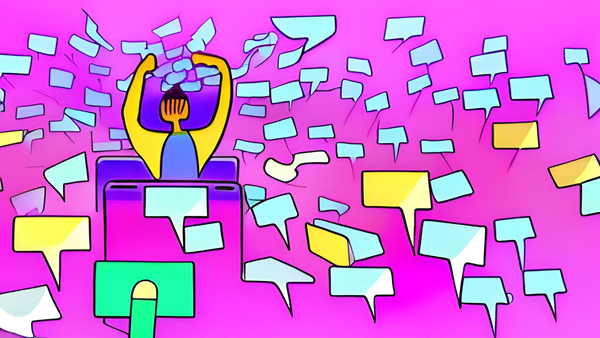01: Valuing customers, doing it yourself, and loving your first follower

Hello! And thanks for subscribing.
I’ve toyed with the idea of a newsletter for a while. I got into this whole marketing thing through a love of writing, and studying Journalism in the mid 00s. Twitter’s great, and I owe it a lot, but there’s something a bit more satisfying about writing more long form. And for the love of it, rather than for work (as much as I like that as well - hello if I do it for you!).
By way of introduction, inform, educate, entertain were the values that Lord Reith wanted the BBC to embody when it was founded in the 1920s. All of the station’s output needed to do one of those three things.
When I started delivering apprenticeships and coaching small-to-medium-sized businesses after years of living and breathing social media, I found that it’s a pretty succinct way of explaining what to do in social media. When you set up a business, or get handed the keys to a company’s social channels for the first time, there’s so much conflicting information out there.
Post at 2pm on a Thursday. Do more videos. Get on the newest social media channel. Post 27 times a day. It’s endless. And that’s before the unsolicited advice from well-meaning friends and family members. It’s no wonder people feel incredibly overwhelmed when they have to start with nothing.
That’s when I started using the inform, educate, entertain mantra. I’ve been told it helps people, and it’s pretty easy to remember too. One of these days I’ll finish my longer form explanation of why I’ve adopted it and how to use it.
This newsletter will combine those three elements and apply them to what’s going on in marketing and education. They’re the two broad areas I get involved in, and it’s always best to stick to your lane.
Anyway, on with the show.
Business values = lifetime customer value
At the end of April, my four-year-old took a bit of a tumble at school and broke his arm. Not what you want a week before your fifth birthday and your first ever party (at a soft play of all places), but he’s dealt with it all brilliantly. He only managed to miss two and a half days of school in total - there’s probably a lesson around resilience there, but I’m going to talk about what happened in the aftermath from a customer perspective.
Due to his limited mobility, and the risk of re-injury, we’ve had to cancel a few weekly things temporarily while he recovers. These were:
- His weekly kickboxing lessons with a local company (which he’d only been going to for a few weeks).
- His weekly swimming lesson with a national company, backed by an Olympian (which he’d been doing brilliantly at for months).
We had a bit of a mixed bag when it came to our experiences. And there is a marketing point that I’m getting to.
- Kickboxing were great. They told us they’d freeze his membership for however long it took for him to return, and to just let them know when he was ready to go back. This means them keeping his place in the class, and having an empty space for a few weeks (it’s about £25 per month).
- His swimming lesson was less than accommodating. They gave us two options: either just continue paying the full amount (around £35 per month), and when he returns they’ll refund us 50% of what we’ve paid if we provide a doctor’s note, or; cancel his place completely and hope they have availability still when he’s ready to go back.
I’d put two of those three down as being positive experiences, and one as the opposite.
When businesses grow it’s often hard to for them to retain their values, and to do The Right Thing in the name of customer satisfaction. Ironically, the monthly fee is probably worth more to the local kickboxing company than it is to the national swimming lesson company. But their reactions were the opposite way round to what I’d have expected. One company respects and values its customers and, in my opinion, the other one doesn’t.
I’m a big believer in doing The Right Thing by customers. It’s one of the reasons I went self-employed to begin with.
The kickboxing company has built up a bit of brand equity with us now; we’ll allow some mis-steps in our relationship in future, as we know they try to do The Right Thing. We might stick with them even longer, meaning our lifetime value far outweighs the extra few weeks of payments they could have had from us.
The swimming company? It’s made us think about looking for other providers, and it’s made my wife and I discuss a couple of the issues we’ve had with them in the past. In this case, our lifetime value may decrease for the sake of them wanting a month’s extra payment.
And my son? After 12 days, and his arm in a big cast, he was riding his bike around the garden shouting “I can do it with one hand!”. I don’t think there are many lessons to learn there.
The best thing I’ve read recently
Richard Shotton is one of my favourite people to follow on Twitter. His book - The Choice Factory - covers behavioural science in marketing. And he regularly posts snippets of other studies and pieces of evidence that you can actively use.
He recently shared this extract from Jonah Berger (his book Contagious is in my all-time top 10), explaining how we get people to come round to our way of thinking.

Anyone who’s ever had to get a child to do something will be nodding right now.
I use this paragraph to explain marketing to students. The best decisions are made by our customers, we just have to ensure they’ve got everything they need in order to do so. That’s partly why inform, educate, entertain works as a social strategy.
It’s also similar to a cognitive bias informally called the Ikea effect: if we make something ourselves we have a lot more attachment to it. A 2011 study found that customers were willing to pay 63% more for furniture if they’d been involved in making it themselves compared to something pre-assembled (full Harvard research is here, but the HuffPo summary covers the key points).
When I was a phone salesman working in-store for O2 - 2005 to 2009, I think - I used this without realising. People would love to tell me that they’d seen cheaper deals at Phones4U or Carphone Warehouse. I’d agree, and tell them to go and take advantage of it. I’d even write down everything we’d discussed about their requirements and usage, and the phone we’d settled on. And then I’d cheerily wish them well.
A lot of people came back. They’d gone somewhere for a cheaper deal, but didn’t like being up-sold or cross-sold packages or phones they didn’t want. They liked that I was working with them to find the right solution, and that they were empowered to make the final decision.
(In truth, this was because as an 18-year-old on a reasonable hourly rate living with my parents I really didn’t care about my sales figures so I went for the solution that caused me less aggro)
What is true is that we don’t build relationships by putting up barriers. It’s why there are also three main things you shouldn’t discuss with customers: politics, religion, and football. You’re never going to change someone’s opinion in those areas, resulting in more barriers.
As a Geordie working in Sunderland this involved a lot of smiling and keeping quiet. But that’s also not a bad skill to learn.
Turning a lone nut into a movement
I love this video. It perfectly highlights how movements start. The commentary says pretty much everything.
How do we use this? Testimonials and case studies are your friends. After every project, every job, even every interaction, ask customers for feedback, quotes, reviews, whatever you think is best for your business.
A busy company that’s doing lots of work looks like a successful company. Champion every single thing that you do, especially in the early stages.
If you need help writing case studies, this Substack from Ash Read is the best advice I’ve come across. This was the first issue, and unfortunately he only did three, but it helps you correctly position both your company and your customer. You’re not the hero in this story, so make it about them.
And if in doubt, watch the way our lone dancing friend embraces the first person who joins in and celebrates them getting involved.




